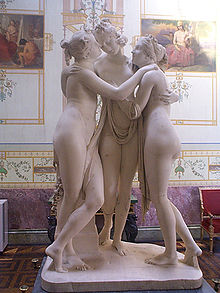


Aglaea (/əˈɡliːə/) or Aglaïa (/əˈɡlaɪə/; Ancient Greek: Ἀγλαΐα, lit. 'festive radiance'[1]) is one of the three CharitesinGreek mythology, also called the Gratiae (Graces) in Roman mythology.
According to Hesiod and other sources (including Apollodorus), Aglaea was one of the three Charities, along with Euphrosyne (mirth) and Thalia (abundant), who were the daughters of Zeus and the Oceanid Eurynome.[2][3][4][5] Other sources name the same three Charites (Aglaea, Euphrosyne and Thalia) but give them different parents. The Orphic Hymn to the Graces says they are the daughters of Zeus and Eunomia (goddess of good order and lawful conduct),[6] and Pindar says that they are daughters of the strongest god (i.e. Zeus) without naming their mother.[7] Hesiod says also that Aglaea is the youngest of the Charites.[8][1][4][9][10]
According to the Dionysiaca, Aglaea is one of the "dancers of Orchomenus" (i.e. the Charites, per Pindar[7]), along with Pasithea and Peitho, who attend Aphrodite. When Aphrodite jealously attempts to weave better than Athena, the Charites help her do so, with Aglaea passing her the yarn.[11] Aglaea also acts as Aphrodite's messenger, and is sent to find and bring a message to Eros, who travels back to Aphrodite much faster because he can fly whereas Aglaea cannot. Aglaea here is referred to as a Charis (singular of Charites), but other characters not of this group are also named Charis, including by Aglaea.[12]
Hesiod says that Aglaea was married to Hephaestus.[8] (This is often seen as after his divorce from Aphrodite.) The Orphic Fragments compiled by Otto Kern say that by Hephaestus, Aglaea became mother of Eucleia ("Good Repute"), Eupheme ("Acclaim"), Euthenia ("Prosperity"), and Philophrosyne ("Welcome").[13] The Iliad and Dionysiaca refer to the wife of Hephaestus as Charis,[14][15] and some scholars conclude that these references refer to Aglaea.[4]
|
Ancient Greek deities
| |||||||||||||
|---|---|---|---|---|---|---|---|---|---|---|---|---|---|
| Primordial deities |
| ||||||||||||
| Titans |
| ||||||||||||
| Olympian deities |
| ||||||||||||
| Water deities |
| ||||||||||||
| Chthonic deities |
| ||||||||||||
| Personifications |
| ||||||||||||
| Other deities |
| ||||||||||||